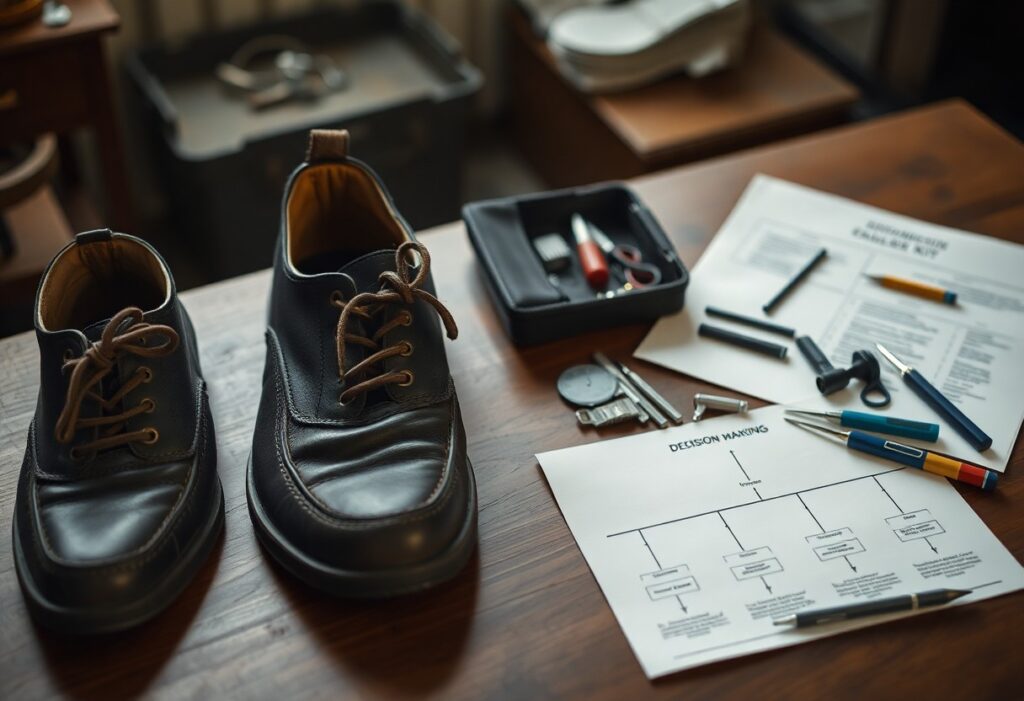
This detailed guide aims to equip you with the knowledge necessary to make savvy decisions about your footwear. When your shoes show signs of wear, deciding between repairing and replacing can have a considerable effect on your budget while also prolonging the lifespan of your cherished footwear. Your choice should be guided by key elements such as the original quality of your shoes, the extent of the damage, and the estimated repair expenses. For example, if you own premium leather shoes that are suffering from sole wear or heel damage, opting for repairs could be a wise financial move. However, if the upper leather is severely compromised or multiple structural problems exist, a replacement might be necessary. Grasping these critical factors will empower you to care for your footwear more effectively and make economically sound decisions.
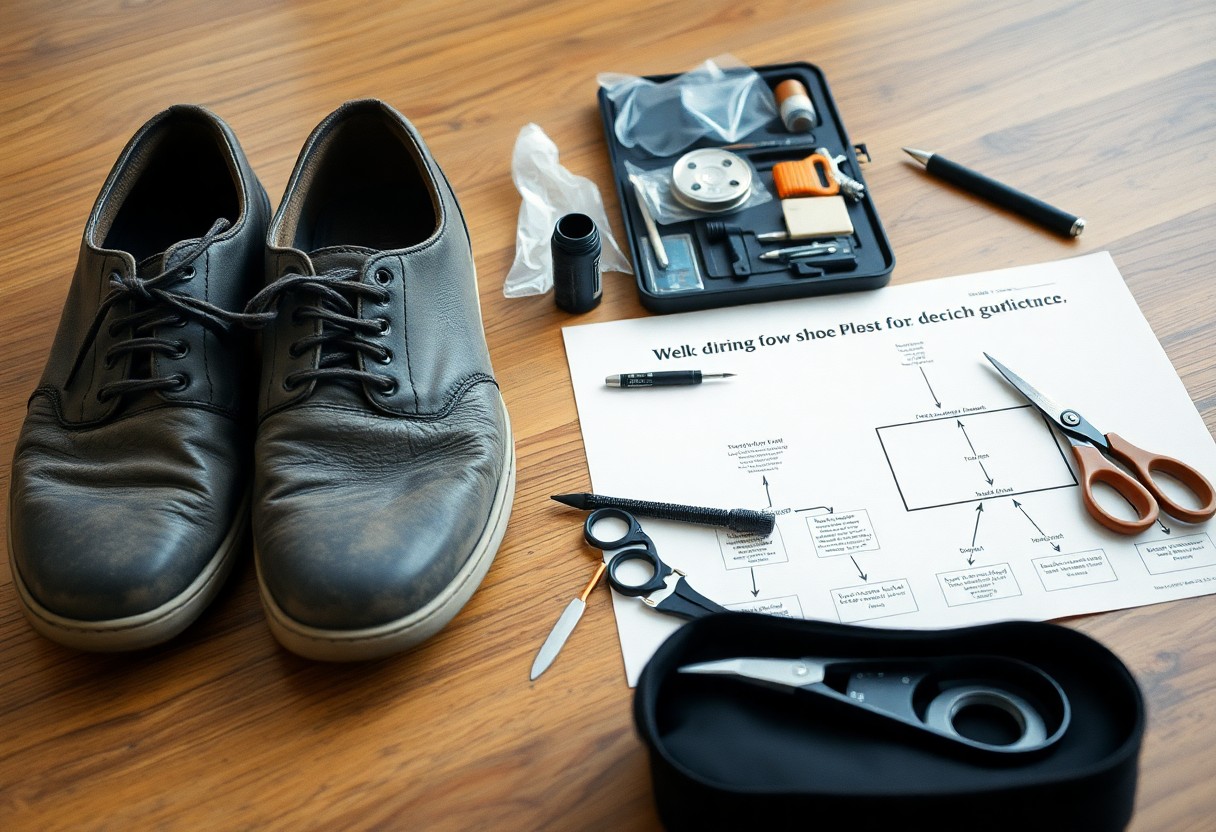
Recognize Common Shoe Damage Types to Make Informed Decisions
Before deciding whether to repair or replace your shoes, it’s vital to understand the common types of damage that can affect your footwear. Shoes can suffer wear in several key areas, including soles, heels, uppers, and structural components. By identifying these issues early on, you can significantly improve your ability to make informed decisions regarding necessary repairs and maintenance.
| Damage Type | Repair Possibility |
| Sole Wear | Usually repairable |
| Heel Damage | Highly repairable |
| Upper Leather Cracks | Limited repair options |
| Structural Issues | Case-dependent |
| Cosmetic Damage | Mostly repairable |
Proactively Addressing Sole and Heel Issues for Extended Shoe Life
The soles of shoes are often the first to exhibit signs of wear, with heel deterioration being one of the most common problems. If you notice uneven wear patterns or the edges of your heels becoming worn down, your shoes need immediate attention. Tackling these issues early can not only prevent further damage but also enhance the comfort and functionality of your footwear.
Identifying Upper Leather Issues and Their Consequences
For leather shoe owners, encountering creasing, cracking, and scratches is quite typical. These concerns often arise from daily use and insufficient care. Recognizing the severity of leather damage is crucial, as it can vary widely. Some shoes may only show surface scratches that are straightforward to fix, while others may display deeper cracks that complicate the repair process and may require more extensive work.
Understanding Structural Damage and Its Implications
Structural problems in shoes can include separated soles, broken shanks, and damaged welts. The structural integrity of your footwear greatly affects both comfort and safety. Typically, repairs to structural components necessitate the expertise of a professional. A skilled cobbler can assess whether the damage is repairable or if a replacement would be the more sensible option.
Revitalizing Your Shoes: Tackling Cosmetic Damage
Surface scuffs, fading colors, and minor scratches fall under the category of cosmetic damage. Fortunately, most shoes can often be revitalized with appropriate care and treatment. Cosmetic repairs are generally among the most cost-effective solutions available. With professional cleaning and refinishing services, your footwear can regain its appearance, making them look nearly new and enhancing their overall aesthetic.
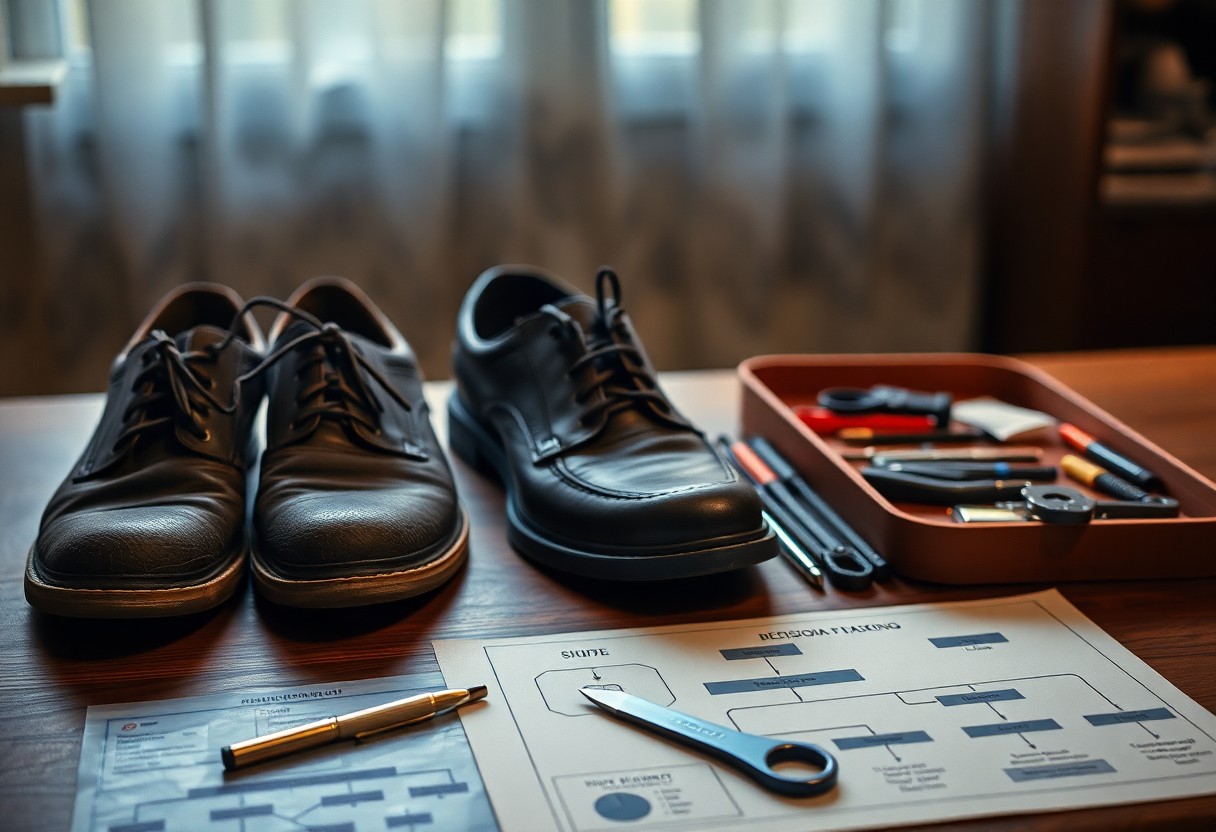
Evaluate Essential Factors Before Choosing Repairs or Replacement
Before deciding to repair or replace your shoes, it’s crucial to weigh several key factors. Consider the age and condition of the shoes, compare repair costs with the price of new footwear, assess the quality of materials, and reflect on any personal attachment you may have to the shoes. Balancing practical considerations with financial implications is essential for making the right choice.
- Overall condition assessment
- Cost comparison
- Material quality check
- Sentimental value evaluation
Thoroughly Assessing the Age and Condition of Your Footwear
If your shoes are relatively new—say, less than two years old—and exhibit minimal wear aside from some issues with the soles or heels, then opting for repairs often makes sense. Take the time to inspect the upper materials for any cracks, evaluate the condition of the insoles, and closely examine the stitching to ensure that your footwear remains in good condition overall.
Cost Analysis: Repairing Shoes Versus Purchasing New Ones
| Basic Repairs | €15-60 |
| Major Repairs | €70-200 |
| New Quality Shoes | €200-500 |
As a general guideline, repair costs should not exceed 50% of the price of new shoes for the decision to be financially practical. This benchmark serves as a critical point of reference when assessing your options.
| Heel Replacement | €15-30 |
| Half Sole Repair | €70-120 |
| Full Sole Repair | €130-200 |
| Heel Lining | €25-60 |
Evaluating the Quality of Materials and Shoe Durability
The construction type and material quality of your shoes are crucial factors in your decision-making process. Welted shoes made from full-grain leather tend to be more amenable to repairs compared to cemented shoes crafted from synthetic materials. The ability to repair a shoe is often directly related to its construction method.
High-quality welted shoes can generally withstand multiple repairs, while less expensive cemented shoes may not justify the time and cost of fixing. Understanding the materials and construction techniques will help you make more informed choices regarding your footwear.
Evaluating Sentimental Value in Your Repair Decision
Even shoes that are showing significant wear may still be worth repairing if they hold special significance or are rare vintage finds that you cherish. Factors such as comfort, fit, and emotional connection to the footwear can justify higher repair costs. As you weigh the practical elements of your decision, don’t overlook these personal values that could influence your final choice.
Determining When to Repair Your Footwear for Maximum Longevity
Your choice to repair shoes should be based on their overall condition and intrinsic value. If your footwear features high-quality leather uppers and possesses solid construction, repairs can greatly extend their functional lifespan. Consider proceeding with repairs when damage is localized, such as to the soles or heels, while maintaining the overall structural integrity of the shoes.
Spotting Repairable Conditions in Your Footwear
Several fixable issues indicate that shoes are worth repairing, such as worn soles, damaged heels, loose stitching, and minor leather scuffs. If the upper leather is intact and the insoles show no signs of cracking, your shoes are good candidates for repair. Basic repair expenses typically range from $15-60, making them a financially sound option.
Recognizing Cost-Effective Repair Opportunities
The best time to repair your shoes is when the repair cost is less than 50% of the price of new shoes. Premium leather footwear, particularly those with welted constructions, are often worth repairing, especially when basic resoling ($70-120) is considerably less than buying new high-quality shoes.
Conditions that justify repairs include high-quality construction, minimal wear on the upper parts, and damage limited to easily replaceable components. Ensure your shoes have intact insoles and uncracked upper leather to validate repair costs ranging from $25 for heel replacement to $200 for full sole repairs.
Anticipating the Advantages of Professional Repairs
With expertly conducted repairs, you can expect restored functionality and a significantly extended lifespan for your footwear. Well-executed repairs can provide several additional years of use, especially with quality resoling or heel replacement work. The longevity of repairs may vary based on the type performed: heel replacements can last anywhere from 6 months to 2 years, while resoled shoes can deliver an additional 2-5 years of service with proper care. Your repaired footwear should continue to feel comfortable and stable, retaining their original fit and support.
Recognizing the Signs That Indicate It’s Time for New Shoes
It becomes essential to replace your shoes when repair costs exceed 50% of the price of new shoes, or when structural damage makes repairs impractical. Warning indicators may include severe cracks in the upper leather, compromised insoles, or multiple repair needs arising at once.
Identifying Damage Situations That Are Beyond Repair
Some types of damage are irreparable, and it’s crucial to recognize them. Look for deep cracks in various areas of the upper leather, severely damaged insoles, or widespread structural failures. When these issues arise, it is wise to begin searching for replacements rather than attempting repairs.
Financial Analysis of Repair Versus Replacement Options
Not all repairs offer equal financial value. Basic repairs such as heel replacements (€15-30) and sole repairs (€70-120) can be economical ways to maintain quality shoes. However, if multiple repairs are needed at once, it may indicate that it’s time to consider new shoes. Given that quality welted shoes generally range from €200-500, comparing repair costs to the original price of the shoes is vital. If the total repair costs exceed half the price of new footwear, then purchasing new shoes becomes the more sensible financial decision.
Prioritizing Safety Considerations When Evaluating Footwear
Worn-out shoes can pose serious risks, including potential foot injuries and accidents. Signs such as completely smooth soles, exposed steel toe caps, or compromised water resistance indicate that your shoes may no longer provide adequate protection. Safety assessments should also take into account your working environment; if you are in hazardous conditions or require specific safety features, even minor structural issues can render your shoes unsafe. It’s crucial not to compromise your safety by continuing to wear damaged footwear.
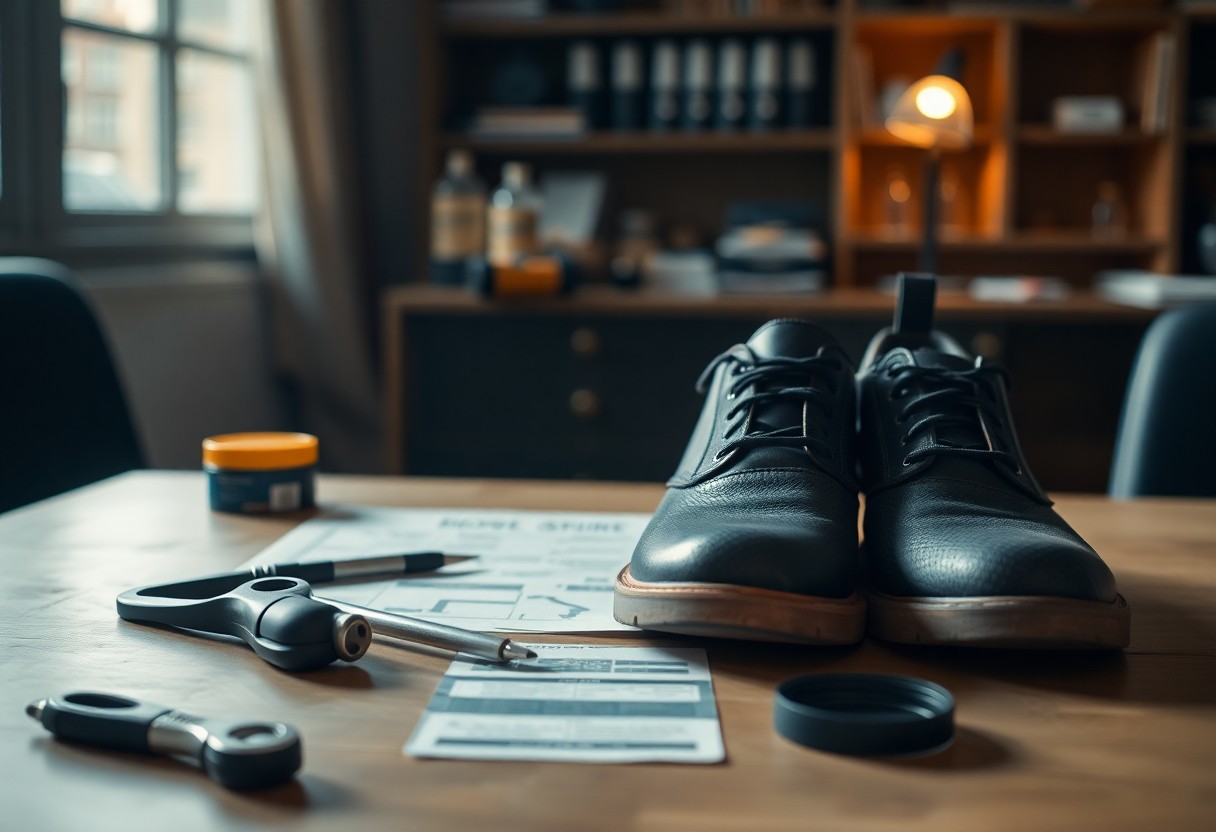
Your Step-by-Step Guide for Systematic Shoe Assessment
To keep your shoe evaluation organized and efficient, follow this systematic approach to determine whether to repair or replace your shoes.
| Repair Indicators | Replacement Indicators |
| Worn soles (no welt damage) | Cracked insoles |
| Heel wear (surface only) | Multiple upper cracks |
| Minor scratches | Severe structural damage |
Thorough Damage Evaluation Process for Informed Decisions
The first step in evaluating your shoes involves examining them in adequate lighting. Pay close attention to the soles, heels, upper leather, and insoles for any signs of wear. A half sole replacement typically costs between €70-120, while a full sole repair can range from €130-200.
- Sole integrity check
- Upper leather inspection
- Heel stability assessment
- Insole condition evaluation
Maximizing Professional Consultation for Optimal Outcomes
Consulting a qualified professional can significantly enhance your ability to make informed decisions about your shoes’ future. Here are important tips to remember:
- Seek multiple opinions if necessary
- Ask about repair costs upfront
- Request timeline estimates for the repair process
- Compare repair estimates with new shoe prices
When visiting a cobbler, it’s advisable to bring both shoes for a thorough assessment. Document any specific issues you’ve encountered and ask about warranty coverage for the proposed repairs. Knowing that a professional evaluation typically costs between €15-30 can also help you budget for this service.
Exploring Professional Repair Services for Your Footwear
To extend the life of your shoes, utilizing professional repair services can provide specialized solutions for various footwear issues. Local cobblers are skilled in handling everything from basic resoling to complex leather repairs, often at a fraction—30-50%—of the cost of buying new shoes. The choice to repair ultimately depends on the quality of the shoe and the extent of the damage.
Understanding the Range of Shoe Repair Services Available
| Service | Average Cost |
|---|---|
| Heel Replacement | $15-30 |
| Full Sole Replacement | $50-70 |
| Leather Patching | $20-40 |
| Stitching Repair | $10-25 |
| Stretching | $15-20 |
- Resoling – Complete sole replacement
- Heel repair – Replacing worn heel tips
- Leather work – Patching and restoration
- Stretching – Adjusting shoes for size
How to Find a Qualified Cobbler for Your Repair Needs
When searching for a dependable shoe repair professional, focus on certified cobblers with positive customer feedback and a minimum of five years of experience. The best candidates typically include shoe repair shops equipped with specialized tools and a demonstrated history of successfully handling your specific type of footwear.
For example, you can verify a cobbler’s qualifications by checking for their certification from the Shoe Service Institute of America, evaluating the cleanliness of their workshop, and requesting to see examples of their previous repair work. Local shoe stores may also have connections with trusted repair professionals and can provide reliable referrals.
Make Informed Choices for Your Footwear Needs
With the insights provided, you now possess the tools needed to make more informed decisions on whether to repair or replace your shoes. Shoes are generally repairable when damage is confined to the soles, heels, buckles, or surface scratches. Conversely, consider buying new footwear when identifying cracks in the upper leather or insole, as these repairs often incur higher costs than replacement and rarely yield satisfactory results. The key is to maintain your shoes properly and to address repairs in a timely manner. By carefully weighing repair costs against the shoe’s overall value and condition, you can effectively extend the life of your footwear while also saving money in the long run.
Frequently Asked Questions (FAQ) About Shoe Repair and Replacement
Q: How can I decide if my shoes are worth repairing or if I should buy new ones?
A: Consider the following essential factors: If your shoes have high-quality leather uppers without cracks and only require repairs to the soles or heels, then repairs are advisable. The total repair cost should be less than 50% of the price of new shoes. Basic repairs such as heel replacements ($20-35) and resoling ($70-120) are typically sound choices for quality shoes. If the upper leather shows cracks, the insole is damaged, or repairs exceed half the price of new footwear, consider purchasing new shoes.
Q: Which shoe repairs are the most cost-effective?
A: The most affordable repairs include heel replacements ($20-35), heel lining repairs ($25-60), and simple reglues of separated parts ($10-20). These repairs can significantly prolong the lifespan of your shoes at a minimal cost. Half-sole replacements ($70-120) also provide good value for quality welted shoes. It’s crucial not to postpone essential repairs, as delays may lead to more expensive damages that could ultimately require total shoe replacement.
Q: What types of shoe damage are generally considered irreparable?
A: There are three main types of damage that render repairs impractical: 1. Deep cracks in the upper leather, especially in creasing areas 2. Structural cracks in the insole 3. Multiple significant damages necessitating repair costs that exceed the price of new shoes. These issues compromise the fundamental structure of the shoe, and repairs often yield unsatisfactory results. In these situations, purchasing new shoes is usually the better alternative.
The Article Guide on deciding when to repair shoes versus buying new practical tips for making the right choice appeared first on My Shoes Finder
The Article Deciding to Repair Shoes or Buy New: Essential Tips Was Found On https://limitsofstrategy.com
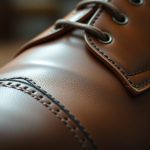

I appreciate how you’ve framed the decision-making process between repairing and replacing shoes, as it really highlights the financial and environmental implications of our choices. I’ve found that investing in quality footwear initially can save money in the long run, as these shoes often withstand wear better than cheaper alternatives. For example, I have a pair of high-quality hiking boots that I’ve owned for years. Despite needing some repairs to the soles, the boots are still holding up remarkably well due to their sturdy construction.
You made a great point about quality footwear and the long-term value it can bring. Those high-quality hiking boots of yours are a perfect example of how investing in well-constructed shoes pays off. It’s always tempting to go for the cheaper options, especially when we’re watching our budgets, but as you’ve noticed, the true cost of shoes often emerges over time.
It’s interesting how much of a difference quality can make in footwear. Your experience with the hiking boots is a perfect example of investing wisely. I’ve had a similar journey with some running shoes I purchased from a small, local brand focusing on sustainability. Initially, the price tag felt a bit steep, but they’ve lasted far longer than any of the cheaper pairs I’ve bought in the past.
I really appreciate how you unpacked the decision-making process between repairing and replacing footwear. I’ve found myself in that dilemma more times than I care to remember, especially with some of my favorite pairs that have seen better days. It’s interesting how a good pair of shoes can feel like an extension of ourselves, and suddenly deciding whether to say goodbye feels so personal.
It’s so relatable to feel that tug when you’re looking at those well-loved shoes. They really do tell a story, don’t they? Each scuff and crease can remind us of adventures, late-night outings, or even just cozy days at home. The decision between repair and replacement can feel like choosing to let go of a piece of our history.
This guide touches on an incredibly important aspect of our daily lives that often gets overlooked: the decision-making process behind shoe maintenance. I can relate to the dilemma of determining whether to repair a favorite pair or invest in a new pair altogether. It’s fascinating to think about how much our footwear choices reflect not just our personal style but also our values—particularly sustainability.
I’ve really enjoyed reading your guide on shoe care and decision-making when it comes to footwear maintenance. It’s definitely a topic that often gets overlooked until we find ourselves staring at a beloved pair of shoes that has seen better days.
It’s great to hear you’ve been enjoying the guide. Shoe care really is a topic that doesn’t get enough attention, isn’t it? So many people invest in a good pair of shoes, but then neglect to maintain them until it’s too late. I find it rather fascinating how much of an impact well-maintained shoes can have on our overall health and comfort.
This guide provides a practical framework for navigating the often-overlooked decision of whether to repair or replace shoes, and I appreciate how it emphasizes the cost-effectiveness of repairs for high-quality footwear. Personally, I’ve found that investing in quality shoes pays off in the long run, especially for styles that I wear frequently, like my leather boots. I had a pair that I thought were beyond saving when the soles started to wear down, but a local cobbler was able to give them a new lease on life.